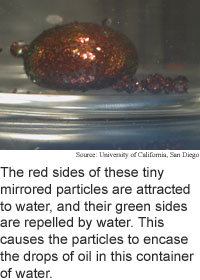
Reflective dust IDs substances
Researchers from the University of California at San Diego have found a way to coax microscopic silicon mirrors to orient so that the mirrors reveal information about their environment.
The tiny mirrored crystals -- dubbed smart dust -- are coated on one side with a molecule that is hydrophobic and oxidized on the other side to render it hydrophilic. When the crystals are added to a mixture of water and dichloromethane, a solvent used in paint remover, the particles align themselves along the boundary between the liquids, with the hydrophilic sides facing the water, and the hydrophobic sides facing dichloromethane. In addition, the dust absorbs some of the dichloromethane, which causes it to change color. Given enough dust, the color change is visible.
The researchers are currently working on attaching antibodies to one side of the crystals. This would enable them to recognize specific types of cells or bioorganisms.
Smart dust could eventually be used to target cancer cells in
the body, or locate and identify pollutants or bacteria in drinking water,
according to the researchers.
That method could be used in high throughput screening for drug
discovery within three years, according to the researchers. The work appeared
in the August 25, 2003 issue of Proceedings of the National Academy
Of Sciences.
Radio tags give guidance
Laser made from single atom
Web searches tap databases
Heated plastic holds proteins
News briefs:
Reflective dust IDs substances
Rapid process shapes aluminum
3D display goes deeper
Artificial DNA stacks metal atoms
Teamed lasers make smaller spots
Glow shows individual DNA

Research Watch blog
View from the High Ground Q&A
How It Works
RSS Feeds:
News
Ad links:
Buy an ad link
Ad links: Clear History
Buy an ad link
|
TRN
Newswire and Headline Feeds for Web sites
|
© Copyright Technology Research News, LLC 2000-2010. All rights reserved.